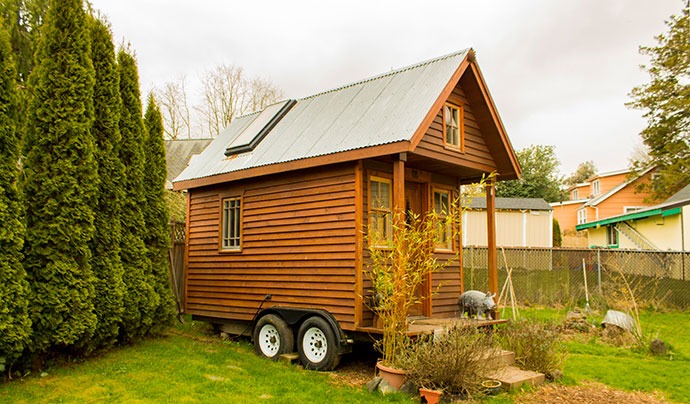
We’re celebrating two things today – Earth Day, and the paperback release of The Big Tiny, Dee Williams’ memoir about building her tiny house on wheels in 2004. In this new excerpt, Dee shares an example of how making thoughtful choices about your building materials can pay off in more ways than one.
Having seen first-hand at work how a landfill full of construction debris was killing the birds flying overhead, she was “obsessive, possibly neurotic” about minimizing her trash, but also found herself, “Completely infatuated with second-use materials: old floorboards, sinks, light fixtures, and windows. I swooned as I stood on the curb looking at a pile of building debris, or while I palmed my way through a box of old faucets at the salvage yard.” Keeping an eye out for used and scrap material helped her minimize her environmental impact, find unique and gorgeous siding for her house, and finally create a connection with a long-time neighbor.
Happy Earth Day to all of you, and cheers to taking an interest in how you can improve the world around you!

From “The Big Tiny” by Dee Williams:
“I liked building my house out of materials that could tell a good story, like this: The whole front of my house is sheathed in old-growth cedar, trees that were likely at least five hundred years old when they were cut down in the 1940s, milled into long tight-grained beveled boards, and sold to a guy who lived in Portland, Oregon. After he got them and sheathed his own house, he stored the leftovers in the attic of his garage, where they sat until the summer of 2004, when I was building my little house.
He walked over one day as I was finishing the roof of my house, and admired the way I’d doubled up the metal sheeting near the ridge so it offered a nice weighty cap. I didn’t have the courage to tell him that I’d measured wrong when installing the roofing and had to tack a short piece near the ridge like a toupee.
I had known this guy for years; he lived a few houses down from me, and we hardly ever exchanged words other than “Hello” and “How ya doing.” He always walked by with his small pug-faced dog in one arm and a short piece of metal pipe in the other hand “to beat back any big dog that tries to take a bite out of Henry here,” he’d explained while nodding at his mutt. He struck me as a gruff, quietly mean old guy, but there he was, standing below me with his pipe and dog, admiring my roof.
“Think you could come see what’s wrong with my garage roof?” he asked, and I obliged, walking down the street in my flip-flops and wondering at this new, kind guy—my new best friend. He explained along the way that the roof had started sagging in one spot, and he wanted to know how to best fix it.
I crawled up a ladder into the garage attic, and that’s when I noticed the old cedar siding stacked up to the rafters covered in dust. I squirmed past the bundle, balancing on the collar ties that made up a makeshift floor, and was able to diagnose his roof problem: “You got a busted rafter up here, but we could likely jack it back into place and sister another rafter alongside.”
I said all of this with a bit of swagger, like a member of the Flannel Shirt Club.
“Humm,” he huffed.
“And,” I continued, “you’ve got a lot of wood up here that might be putting some stress on the old girl, so you might want to think about moving it.”
“Oh, that’s the stuff I got when Cathy and I first built this place, back when your house and mine were nearly the only ones on this block. Back when there was a milking barn where the music store sits,” he muttered.
“Humm,” I offered.
“Maybe you could move it down here? Maybe use it on your little shed?”
“Well . . . I guess so,” I offered, while inside screaming “Jackpot!” and dreaming about how it would feel to have five- hundred-year-old trees—beautiful trees, Oregon trees— wrapped around my house. I’d have preferred to stand in the living forest that begat that stack of lumber—the way a big forest like that filters the light, and everything smells damp and earthy, and like every molecule is breathing—but that wasn’t up to me, so I’d be grateful to settle for the next-best thing: the most stunning beveled siding I’d ever seen.
“You fix that rafter and it’s all yours.”
I hopped down the ladder and raced home for a car jack and some wood to repair his roof, cackling, “Pinch my ass, I’m dreaming!” I never saw this coming—the little house was working its magic, connecting me to people and materials I never would have guessed would find their way into the picture.
I had to spend a lot of time remilling the old cedar so it would match up with the new wood from the lumberyard, and like a total nutball, I spent an entire precious day resawing the thin (two-inch-wide) cedar that I’d ripped off the siding so I could make it into usable window trim. It worked, and years into the future, I still love sitting in my living room, looking up at skylight and seeing the kerf marks on the old cedar that outlines the window.”
